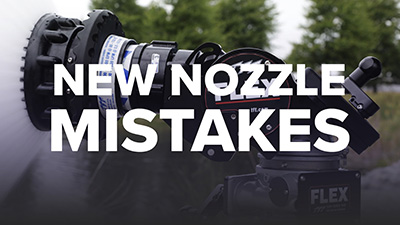3 Mistakes to Avoid with Your New Firefighting Nozzles
Imagine this: You and your crew just wrapped up months of research, comparisons, and testing to find the perfect firefighting nozzles. After carefully weighing all the options, you've made your selection and placed the order. And guess what? Today is the day you receive the delivery!
Getting new equipment is always exciting, but here's the thing: Are you inadvertently making mistakes when putting those new nozzles into service?
Let's dive right in and discuss three crucial mistakes you should avoid with your new nozzles!

1. Not Testing Before Putting the Nozzles in Service
Sure, those freshly arrived nozzles from the factory should be good to go, right?
Ideally, that's the case. However, it's important that you perform a complete nozzle test first. This lets you confirm your nozzles are truly ready to go.
Confirm Nozzle Mechanics
First, a nozzle test helps you confirm that each and every one of your nozzles is working flawlessly. You can scrutinize all the moving parts, test the flow patterns, and carefully inspect for any shipping-induced damage.
While the manufacturer should have already done their due diligence, accidents can still happen. It's best to ensure your nozzles are in perfect working order before you actually need them.
Check the Flow Rate
You ordered nozzles for specific flow rates. A nozzle test enables you to verify that the flow rate matches your expectations. Remember, according to NFPA 1964, your nozzle should not exceed a flow rate that is 10% above the flow rating at the rated base nozzle pressure.
Want to learn more about calculating and using that 10%? Read more here!
Adjust Your Pump Discharge Pressure
Don't make the assumption that your old Pump Discharge Pressure (PDP) will automatically work with your new nozzles. We strongly recommend conducting a thorough test of your nozzle and confirming or updating your PDP accordingly.
You might have chosen a nozzle with a different operating pressure or flow rate. Even switching from one type of nozzle to another can lead to changes. So, it's essential to adapt your PDP to ensure optimal performance.
2. Skipping Training
Your crew must fully understand how to use your new nozzles. Comprehensive training is the key to ensuring they can carry out their duties effectively and support each other on the fire ground. It's crucial that everyone learns the ins and outs of the nozzles, from understanding the settings to becoming familiar with the location of any selector rings or adjustments. They should also get comfortable with the size, weight, and handling of the nozzle, so that using it becomes second nature.
The last thing you want is to fumble with the nozzle during a critical moment because it feels unfamiliar in your hands. Training is the remedy!
3. Forgetting to Update Your SOPs
Your Standard Operating Procedures (SOPs) are crucial resources and policies for your crew. They ensure that everyone is on the same page and acts as a unified front on the fire ground.
Neglecting to update your SOPs leaves your crew with outdated information and procedures, which is not fair to new members or those who regularly review them. So, make it a point to update your SOPs to incorporate any new information or procedures.
Conclusion
Getting new nozzles is an exciting occasion for any department. Remember to set yourself up for success by completing a full nozzle test before putting them in service, training the whole crew on how to use them, and updating your standard operating procedures.
